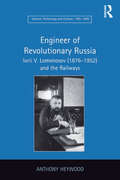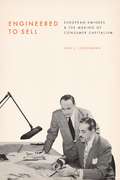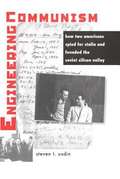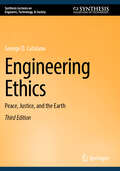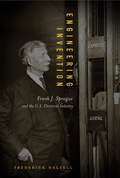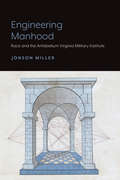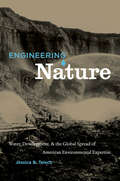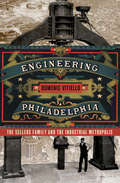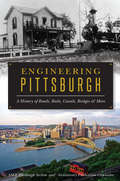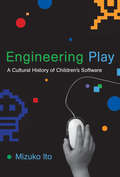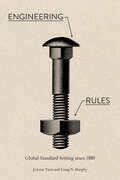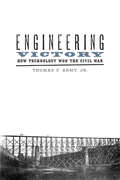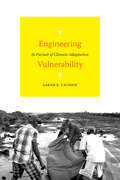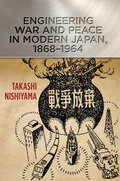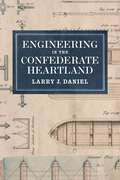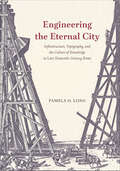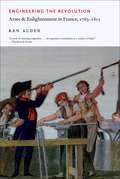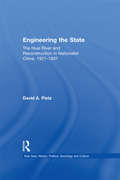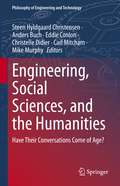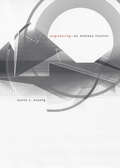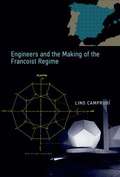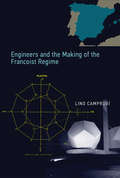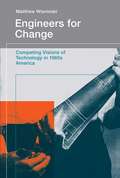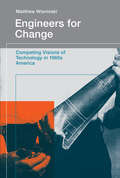- Table View
- List View
Engineer of Revolutionary Russia: Iurii V. Lomonosov (1876–1952) and the Railways (Science, Technology and Culture, 1700-1945)
by Anthony HeywoodThis book is the first substantial study in any language of one of revolutionary Russia's most distinguished and controversial engineers - Iurii Vladimirovich Lomonosov (1876-1952). Not only does it provide an outline of his remarkable life and career, it also explores the relationship between science, technology and transport that developed in late tsarist and early Soviet Russia. Lomonosov's importance extends well beyond his scientific and engineering achievements thanks to the rich variety and public prominence of his professional and political activities. His generation - Lenin's generation - was inevitably at the forefront of Russian life from the 1910s to the 1930s, and Lomonosov took his place there as one of the country's best known and ultimately notorious engineers. As well as an innovative engineer who campaigned to enhance the role of science, he played a major role in shaping and administering the Russian railways, and undertook several diplomatic and scientific missions to the West during the early years of the Revolution. Falling from political favour during an assignment in Germany (1923-1927), he achieved notoriety in Russia as a 'non-returner' by apparently declining to return home. Thereby escaping probable arrest and execution, he began a new life abroad (1927-1952) which included a research post at the California Institute of Technology in 1929-1930, collaborative projects with the famous physicist P.L. Kapitsa in Cambridge, a long-time association with the Institution of Mechanical Engineers in London, and work for the British War Office during the Second World War. From Marxist revolutionary to American academic, this study reveals Lomonosov's extraordinary life. Drawing on a wide variety of official Russian sources, as well as Lomonosov's own diaries and memoirs, a vivid portrait of his life is presented, offering a better understanding of how science, technology and politics interacted in early-twentieth-century Russia.
Engineered to Sell: European Émigrés and the Making of Consumer Capitalism
by Jan L. LogemannThe mid-twentieth-century marketing world influenced nearly every aspect of American culture—music, literature, politics, economics, consumerism, race relations, gender, and more. In Engineered to Sell, Jan L. Logemann traces the transnational careers of consumer engineers in advertising, market research, and commercial design who transformed capitalism from the 1930s through the 1960s. He argues that the history of marketing consumer goods is not a story of American exceptionalism. Instead, the careers of immigrants point to the limits of the “Americanization” paradigm. Logemann explains the rise of a dynamic world of goods and examines how and why consumer engineering was shaped by transatlantic exchanges. From Austrian psychologists and little-known social scientists to the illustrious Bauhaus artists, the emigrés at the center of this story illustrate the vibrant cultural and commercial connections between metropolitan centers: Vienna and New York; Paris and Chicago; Berlin and San Francisco. By focusing on the transnational lives of emigré consumer researchers, marketers, and designers, Engineered to Sell details the processes of cultural translation and adaptation that mark both the midcentury transformation of American marketing and the subsequent European shift to “American” consumer capitalism.
Engineering Communism: How Two Americans Spied for Stalin and Founded the Soviet Silicon Valley
by Steven T. UsdinEngineering Communism is the fascinating story of Joel Barr and Alfred Sarant, dedicated Communists and members of the Rosenberg spy ring, who stole information from the United States during World War II that proved crucial to building the first advanced weapons systems in the USSR. On the brink of arrest, they escaped with KGB's help and eluded American intelligence for decades. Drawing on extensive interviews with Barr and new archival evidence, Steve Usdin explains why Barr and Sarant became spies, how they obtained military secrets, and how FBI blunders led to their escape. He chronicles their pioneering role in the Soviet computer industry, including their success in convincing Nikita Khrushchev to build a secret Silicon Valley. The book is rich with details of Barr's and Sarant's intriguing and exciting personal lives, their families, as well as their integration into Russian society. Engineering Communism follows the two spies through Sarant's death and Barr's unbelievable return to the United States.
Engineering Eden: The True Story of a Violent Death, a Trial, and the Fight over Controlling Nature
by Jordan Fisher SmithThe fascinating story of a trial that opened a window onto the century-long battle to control nature in the national parks. When twenty-five-year-old Harry Walker was killed by a bear in Yellowstone Park in 1972, the civil trial prompted by his death became a proxy for bigger questions about American wilderness management that had been boiling for a century. At immediate issue was whether the Park Service should have done more to keep bears away from humans, but what was revealed as the trial unfolded was just how fruitless our efforts to regulate nature in the parks had always been. The proceedings drew to the witness stand some of the most important figures in twentieth century wilderness management, including the eminent zoologist A. Starker Leopold, who had produced a landmark conservationist document in the 1950s, and all-American twin researchers John and Frank Craighead, who ran groundbreaking bear studies at Yellowstone. Their testimony would help decide whether the government owed the Walker family restitution for Harry's death, but it would also illuminate decades of patchwork efforts to preserve an idea of nature that had never existed in the first place. In this remarkable excavation of American environmental history, nature writer and former park ranger Jordan Fisher Smith uses Harry Walker's story to tell the larger narrative of the futile, sometimes fatal, attempts to remake wilderness in the name of preserving it. Tracing a course from the founding of the national parks through the tangled twentieth-century growth of the conservationist movement, Smith gives the lie to the portrayal of national parks as Edenic wonderlands unspoiled until the arrival of Europeans, and shows how virtually every attempt to manage nature in the parks has only created cascading effects that require even more management. Moving across time and between Yellowstone, Yosemite, and Glacier national parks, Engineering Eden shows how efforts at wilderness management have always been undone by one fundamental problem--that the idea of what is "wild" dissolves as soon as we begin to examine it, leaving us with little framework to say what wilderness should look like and which human interventions are acceptable in trying to preserve it. In the tradition of John McPhee's The Control of Nature and Alan Burdick's Out of Eden, Jordan Fisher Smith has produced a powerful work of popular science and environmental history, grappling with critical issues that we have even now yet to resolve.
Engineering Ethics: Peace, Justice, and the Earth (Synthesis Lectures on Engineers, Technology, & Society)
by George D. CatalanoIn the original two editions of Engineering Ethics: Peace, Justice, and the Earth, a response of the engineering profession to the challenges of security, poverty and underdevelopment, environmental sustainability, and native cultures was described. Ethical codes, which govern the behavior of engineers, were examined from a historical perspective linking the prevailing codes to models of the natural world. A new ethical code based on a recently introduced model of Nature as an integral community was provided and discussed. Applications of the new code were described using a case study approach. The proposed third edition will build on the foundational material included in the previous two editions. Over the course of the last decade new and profoundly challenging ethical issues (synthetic biology, artificial intelligence, climate change and the sixth extinction) have arisen in the engineering profession. The notion of an integral community has been more fully developed. The proposed book will include an exploration of these issues as well as provide the reader with a better understanding of the historical development of ethical reasoning and consider future possibilities. Implications of the innovative ideas in ethics and design on engineering education are also considered.
Engineering Invention: Frank J. Sprague and the U.S. Electrical Industry
by Frederick DalzellThe technological breakthroughs and entrepreneurial adventures of Frank J. Sprague during the transformative years of the early electrical industry. Over the course of a little less than twenty years, inventor Frank J. Sprague (1857-1934) achieved an astonishing series of technological breakthroughs—from pioneering work in self-governing motors to developing the first full-scale operational electric railway system—all while commercializing his inventions and promoting them (and himself as their inventor) to financial backers and the public. In Engineering Invention, Frederick Dalzell tells Sprague's story, setting it against the backdrop of one of the most dynamic periods in the history of technology. In a burst of innovation during these years, Sprague and his contemporaries—Thomas Edison, Nicolas Tesla, Elmer Sperry, George Westinghouse, and others—transformed the technologies of electricity and reshaped modern life. After working briefly for Edison, Sprague started the Sprague Electric Railway and Motor Company; designed and built an electric railroad system for Richmond, Virginia; sold his company to Edison and went into the field of electric elevators; almost accidentally discovered a multiple-control system that could equip electric train systems for mass transit; started a third company to commercialize this; then sold this company to Edison and retired (temporarily). Throughout his career, Dalzell tells us, Sprague framed technology as invention, cast himself as hero, and staged his technologies as dramas. He toiled against the odds, scraped together resources to found companies, bet those companies on technical feats—and pulled it off, multiple times. The idea of the “heroic inventor” is not, of course, the only way to frame the history of technology. Nevertheless, as Dalzell shows, Sprague, Edison, and others crafted the role consciously and actively, using it to generate vital impetus behind the process of innovation.
Engineering Manhood: Race and the Antebellum Virginia Military Institute
by Jonson MillerIt is not an accident that American engineering is so disproportionately male and white; it took and takes work to create and sustain this situation. Engineering Manhood: Race and the Antebellum Virginia Military Institute examines the process by which engineers of the antebellum Virginia Military Institute cultivated whiteness, manhood, and other intersecting identities as essential to an engineering professional identity. VMI opened in 1839 to provide one of the earliest and most thorough engineering educations available in antebellum America. The officers of the school saw engineering work as intimately linked to being a particular type of person, one that excluded women or black men. This particular white manhood they crafted drew upon a growing middle-class culture. These precedents impacted engineering education broadly in this country and we continue to see their legacy today.
Engineering Nature: Water, Development, and the Global Spread of American Environmental Expertise
by Jessica B. TeischFocusing on globalization in the late nineteenth and early twentieth centuries, Jessica Teisch examines the processes by which American water and mining engineers who rose to prominence during and after the California Gold Rush of 1849 exported the United States' growing technical and environmental knowledge and associated social and political institutions. In the frontiers of Australia, South Africa, Hawaii, and Palestine--semiarid regions that shared a need for water to support growing populations and economies--California water engineers applied their expertise in irrigation and mining projects on behalf of foreign governments and business interests. Engineering Natureexplores how controlling the vagaries of nature abroad required more than the export of blueprints for dams, canals, or mines; it also entailed the problematic transfer of the new technology's sociopolitical context. Water engineers confronted unforeseen variables in each region as they worked to implement their visions of agrarian settlement and industrial growth, including the role of the market, government institutions, property rights, indigenous peoples, labor, and, not last, the environment. Teisch argues that by examining the successes and failures of various projects as American influence spread, we can see the complex role of globalization at work, often with incredibly disproportionate results.
Engineering Philadelphia: The Sellers Family and the Industrial Metropolis
by Domenic VitielloThe Sellers brothers, Samuel and George, came to North America in 1682 as part of the Quaker migration to William Penn’s new province on the shores of the Delaware River. Across more than two centuries, the Sellers family—especially Samuel’s descendants Nathan, Escol, Coleman, and William—rose to prominence as manufacturers, engineers, social reformers, and urban and suburban developers, transforming Philadelphia into a center of industry and culture. They led a host of civic institutions including the Franklin Institute, Abolition Society, and University of Pennsylvania. At the same time, their vast network of relatives and associates became a leading force in the rise of American industry in Ohio, Georgia, Tennessee, New York, and elsewhere. Engineering Philadelphia is a sweeping account of enterprise and ingenuity, economic development and urban planning, and the rise and fall of Philadelphia as an industrial metropolis. Domenic Vitiello tells the story of the influential Sellers family, placing their experiences in the broader context of industrialization and urbanization in the United States from the colonial era through World War II. The story of the Sellers family illustrates how family and business networks shaped the social, financial, and technological processes of industrial capitalism. As Vitiello documents, the Sellers family and their network profoundly influenced corporate and federal technology policy, manufacturing practice, infrastructure and building construction, and metropolitan development. Vitiello also links the family’s declining fortunes to the deindustrialization of Philadelphia—and the nation—over the course of the twentieth century.
Engineering Pittsburgh: A History of Roads, Rails, Canals, Bridges and More
by ASCE Pittsburgh Section 100th Anniversary Publication CommitteeWestern Pennsylvania's infrastructure is renowned for traversing valleys, mountains, rivers and everything in between. Early surveying in the region delineated state and local boundaries that allowed for the mapping of canals, railroads and roadways. Engineers developed bridges, ground transportation systems and airports that linked Pittsburgh to the world. Frequently overflowing rivers transformed into reliable navigation passageways. Drinking water and wastewater treatment systems allowed development and population to flourish, leading to investments in iconic buildings. Join expert civil engineers and professionals as they narrate the story of Pittsburgh and the surrounding region's engineering triumphs.
Engineering Play: A Cultural History of Children's Software (The John D. and Catherine T. MacArthur Foundation Series on Digital Media and Learning)
by Mizuko ItoHow the influential industry that produced such popular games as Oregon Trail and KidPix emerged from experimental efforts to use computers as tools in child-centered learning.Today, computers are part of kids' everyday lives, used both for play and for learning. We envy children's natural affinity for computers, the ease with which they click in and out of digital worlds. Thirty years ago, however, the computer belonged almost exclusively to business, the military, and academia. In Engineering Play, Mizuko Ito describes the transformation of the computer from a tool associated with adults and work to one linked to children, learning, and play. Ito gives an account of a pivotal period in the 1980s and 1990s, which saw the rise of a new category of consumer software designed specifically for elementary school-aged children. “Edutainment” software sought to blend various educational philosophies with interactive gaming and entertainment, and included such titles as Number Munchers, Oregon Trail, KidPix, and Where in the World Is Carmen Sandiego?.The children's software boom (and the bust that followed), says Ito, can be seen as a microcosm of the negotiations surrounding new technology, children, and education. The story she tells is both a testimonial to the transformative power of innovation and a cautionary tale about its limitations.
Engineering Rules: Global Standard Setting since 1880 (Hagley Library Studies in Business, Technology, and Politics)
by JoAnne Yates Craig N. MurphyThe first global history of voluntary consensus standard setting.Finalist, Hagley Prize in Business History, The Hagley Museum and Library / The Business History ConferencePrivate, voluntary standards shape almost everything we use, from screw threads to shipping containers to e-readers. They have been critical to every major change in the world economy for more than a century, including the rise of global manufacturing and the ubiquity of the internet. In Engineering Rules, JoAnne Yates and Craig N. Murphy trace the standard-setting system's evolution through time, revealing a process with an astonishingly pervasive, if rarely noticed, impact on all of our lives. This type of standard setting was established in the 1880s, when engineers aimed to prove their status as professionals by creating useful standards that would be widely adopted by manufacturers while satisfying corporate customers. Yates and Murphy explain how these engineers' processes provided a timely way to set desirable standards that would have taken much longer to emerge from the market and that governments were rarely willing to set. By the 1920s, the standardizers began to think of themselves as critical to global prosperity and world peace. After World War II, standardizers transcended Cold War divisions to create standards that made the global economy possible. Finally, Yates and Murphy reveal how, since 1990, a new generation of standardizers has focused on supporting the internet and web while applying the same standard-setting process to regulate the potential social and environmental harms of the increasingly global economy.Drawing on archival materials from three continents, Yates and Murphy describe the positive ideals that sparked the standardization movement, the ways its leaders tried to realize those ideals, and the challenges the movement faces today. Engineering Rules is a riveting global history of the people, processes, and organizations that created and maintain this nearly invisible infrastructure of today's economy, which is just as important as the state or the global market.
Engineering Victory: How Technology Won the Civil War (Johns Hopkins Studies in the History of Technology)
by Thomas F. Army Jr.Superior engineering skills among Union soldiers helped ensure victory in the Civil War.Engineering Victory brings a fresh approach to the question of why the North prevailed in the Civil War. Historian Thomas F. Army, Jr., identifies strength in engineering—not superior military strategy or industrial advantage—as the critical determining factor in the war’s outcome.Army finds that Union soldiers were able to apply scientific ingenuity and innovation to complex problems in a way that Confederate soldiers simply could not match. Skilled Free State engineers who were trained during the antebellum period benefited from basic educational reforms, the spread of informal educational practices, and a culture that encouraged learning and innovation. During the war, their rapid construction and repair of roads, railways, and bridges allowed Northern troops to pass quickly through the forbidding terrain of the South as retreating and maneuvering Confederates struggled to cut supply lines and stop the Yankees from pressing any advantage.By presenting detailed case studies from both theaters of the war, Army clearly demonstrates how the soldiers’ education, training, and talents spelled the difference between success and failure, victory and defeat. He also reveals massive logistical operations as critical in determining the war’s outcome.
Engineering Vulnerability: In Pursuit of Climate Adaptation
by Sarah E. VaughnIn Engineering Vulnerability Sarah E. Vaughn examines climate adaptation against the backdrop of ongoing processes of settler colonialism and the global climate change initiatives that seek to intervene in the lives of the world’s most vulnerable. Her case study is Guyana in the aftermath of the 2005 catastrophic flooding that ravaged the country’s Atlantic coastal plain. The country’s ensuing engineering projects reveal the contingencies of climate adaptation and the capacity of flooding to shape Guyanese expectations about racial (in)equality. Analyzing the coproduction of race and vulnerability, Vaughn details why climate adaptation has implications for how we understand the past and the continued human settlement of a place. Such understandings become particularly apparent not only through experts’ and ordinary citizens’ disputes over resources but in their attention to the ethical practice of technoscience over time. Approaching climate adaptation this way, Vaughn exposes the generative openings as well as gaps in racial thinking for theorizing climate action, environmental justice, and, more broadly, future life on a warming planet.Duke University Press Scholars of Color First Book Award recipient
Engineering War and Peace in Modern Japan, 1868–1964 (Johns Hopkins Studies in the History of Technology)
by Takashi NishiyamaThe role of engineering communities in taking Japan from a defeated war machine into a peacetime technology leader.Naval, aeronautic, and mechanical engineers played a powerful part in the military buildup of Japan in the early and mid-twentieth century. They belonged to a militaristic regime and embraced the importance of their role in it. Takashi Nishiyama examines the impact of war and peace on technological transformation during the twentieth century. He is the first to study the paradoxical and transformative power of Japan’s defeat in World War II through the lens of engineering.Nishiyama asks: How did authorities select and prepare young men to be engineers? How did Japan develop curricula adequate to the task (and from whom did the country borrow)? Under what conditions? What did the engineers think of the planes they built to support Kamikaze suicide missions? But his study ultimately concerns the remarkable transition these trained engineers made after total defeat in 1945. How could the engineers of war machines so quickly turn to peaceful construction projects such as designing the equipment necessary to manufacture consumer products? Most important, they developed new high-speed rail services, including the Shinkansen Bullet Train. What does this change tell us not only about Japan at war and then in peacetime but also about the malleability of engineering cultures?Nishiyama aims to counterbalance prevalent Eurocentric/Americentric views in the history of technology. Engineering War and Peace in Modern Japan, 1868–1964 sets the historical experience of one country’s technological transformation in a larger international framework by studying sources in six different languages: Chinese, English, French, German, Japanese, and Spanish. The result is a fascinating read for those interested in technology, East Asia, and international studies. Nishiyama's work offers lessons to policymakers interested in how a country can recover successfully after defeat.
Engineering in the Confederate Heartland
by Larry J. DanielWhile engineers played a critical role in the performance of both the Union and Confederate armies during the Civil War, few historians have examined their experiences or impact. Larry J. Daniel’s Engineering in the Confederate Heartland fills a gap in that historiography by analyzing the accomplishments of these individuals working for the Confederacy in the vast region between the Appalachian Mountains and the Mississippi River, commonly referred to as the Western Theater. Though few in number, the members of the western engineer corps were vital in implementing Confederate strategy and tactics.Most Confederate engineers possessed little to no military training, transitioning from the civilian tasks of water drainage, railroad construction, and land surveys to overseeing highly technical war-related projects. Their goal was simple in mission but complex in implementation: utilize their specialized skills to defeat, or at least slow, the Union juggernaut. The geographical diversity of the Heartland further complicated their charge. The expansive area featured elevations reaching over six thousand feet, sandstone bluffs cut by running valleys on the Cumberland Plateau, the Nashville basin’s thick cedar glades and rolling farmland, and the wind-blown silt soil of the Loess Plains of the Mississippi Valley. Regardless of the topography, engineers encountered persistent flooding in all sectors.Daniel’s study challenges the long-held thesis that the area lacked adept professionals. Engineers’ expertise and labor, especially in the construction of small bridges and the laying of pontoons, often proved pivotal. Lacking sophisticated equipment and technical instruments, they nonetheless achieved numerous successes: the Union army never breached the defenses at Vicksburg or Atlanta, and by late 1864, the Army of Tennessee boasted a pontoon train sufficient to span the Tennessee River. Daniel uncovers these and other essential contributions to the war effort made by the Confederacy’s western engineers.
Engineering the Eternal City: Infrastructure, Topography, and the Culture of Knowledge in Late Sixteenth-Century Rome
by Pamela O. LongBetween the catastrophic flood of the Tiber River in 1557 and the death of the “engineering pope” Sixtus V in 1590, the city of Rome was transformed by intense activity involving building construction and engineering projects of all kinds. Using hundreds of archival documents and primary sources, Engineering the Eternal City explores the processes and people involved in these infrastructure projects—sewers, bridge repair, flood prevention, aqueduct construction, the building of new, straight streets, and even the relocation of immensely heavy ancient Egyptian obelisks that Roman emperors had carried to the city centuries before. This portrait of an early modern Rome examines the many conflicts, failures, and successes that shaped the city, as decision-makers tried to control not only Rome’s structures and infrastructures but also the people who lived there. Taking up visual images of the city created during the same period—most importantly in maps and urban representations, this book shows how in a time before the development of modern professionalism and modern bureaucracies, there was far more wide-ranging conversation among people of various backgrounds on issues of engineering and infrastructure than there is in our own times. Physicians, civic leaders, jurists, cardinals, popes, and clerics engaged with painters, sculptors, architects, printers, and other practitioners as they discussed, argued, and completed the projects that remade Rome.
Engineering the Revolution: Arms and Enlightenment in France, 1763-1815
by Ken AlderEngineering the Revolution documents the forging of a new relationship between technology and politics in Revolutionary France, and the inauguration of a distinctively modern form of the “technological life. ” Here, Ken Alder rewrites the history of the eighteenth century as the total history of one particular artifact—the gun—by offering a novel and historical account of how material artifacts emerge as the outcome of political struggle. By expanding the “political” to include conflict over material objects, this volume rethinks the nature of engineering rationality, the origins of mass production, the rise of meritocracy, and our interpretation of the Enlightenment and the French Revolution.
Engineering the State: The Huai River and Reconstruction in Nationalist China, 1927–37 (East Asia: History, Politics, Sociology and Culture)
by David PietzFirst published in 2002. Routledge is an imprint of Taylor & Francis, an informa company.
Engineering, Social Sciences, and the Humanities: Have Their Conversations Come of Age? (Philosophy of Engineering and Technology #42)
by Carl Mitcham Steen Hyldgaard Christensen Christelle Didier Mike Murphy Anders Buch Eddie ConlonThis book presents a critical examination of conversations between engineering, social sciences, and the humanities asking whether their conversations have come of age. These conversations are important because ultimately their outcome have real world consequences in engineering education and practice, and for the social and material world we inhabit. Taken together the 21 chapters provide scholarly-argued responses to the following questions.Why are these conversations important for engineering, for social sciences, and for the humanities?Are there key places in practice, in the curriculum, and in institutions where these conversations can develop best?What are the barriers to successful conversations?What proposals can be made for deepening these conversations for the future?How would we know that the conversations have come of age, and who gets to decide?The book appeals to scholarly audiences that come together through their work in engineering education and practice. The chapters of the book probes and access the meetings and conversations, and they explore new avenues for strengthening dialogues that transcend narrow disciplinary confines and divisions.“The volume offers a rich collection of descriptive resources and theoretical tools that will be useful for researchers of engineering practices, and for those aiming to reshape the engineering lifeworld through new policies. The book depicts the current state of the art of the most visible SSH contributions to shaping engineering practices, as well as a map of research gaps and policy problems that still need to be explored.” - Dr. Ir. Lavinia Marin, TU Delft, Electrical Engineering and Philosophy
Engineering—An Endless Frontier
by Sunny Y. AUYANGGenetic engineering, nanotechnology, astrophysics, particle physics: We live in an engineered world, one where the distinctions between science and engineering, technology and research, are fast disappearing. This book shows how, at the dawn of the twenty-first century, the goals of natural scientists--to discover what was not known--and that of engineers--to create what did not exist--are undergoing an unprecedented convergence. Sunny Y. Auyang ranges widely in demonstrating that engineering today is not only a collaborator with science but its equal. In concise accounts of the emergence of industrial laboratories and chemical and electrical engineering, and in whirlwind histories of the machine tools and automobile industries and the rise of nuclear energy and information technology, her book presents a broad picture of modern engineering: its history, structure, technological achievements, and social responsibilities; its relation to natural science, business administration, and public policies. Auyang uses case studies such as the development of the F-117A Nighthawk and Boeing 777 aircraft, as well as the experiences of engineer-scientists such as Oliver Heaviside, engineer-entrepreneurs such as Henry Ford and Bill Gates, and engineer-managers such as Alfred Sloan and Jack Welch to give readers a clear sense of engineering's essential role in the future of scientific research. Table of Contents: Preface 1. Introduction 2 . Technology Takes Off 2.1 From Practical Art to Technology 2.2 Construction Becomes Mathematical 2.3 Experimenting with Machines 2.4 Science and Chemical Industries 2.5 Power and Communication 3. Engineering for Information 3.1 From Microelectronics to Nanotechnology 3.2 Computer Hardware and Software 3.3 Wireless, Satellites, and the Internet 4. Engineering in Society 4.1 Social Ascent and Images of Engineers 4.2 Partnership in Research and Development 4.3 Contributions to Sectors of the Economy 5. Innovation by Design 5.1 Inventive Thinking in Negative Feedback 5.2 Design Processes in Systems Engineering 5.3 “Working Together� in Aircraft Development 5.4 From Onboard Computers to Door Hinges 6. Sciences of Useful Systems 6.1 Mathematics in Engineering and Science 6.2 Information and Control Theories 6.3 Wind Tunnels and Internet Simulation 6.4 Integrative Materials Engineering 6.5 Biological Engineering Frontiers 7. Leaders Who Are Engineers 7.1 Business Leaders in the Car Industry 7.2 Public Policies and Nuclear Power 7.3 Managing Technological Risks Appendix A. Statistical Profiles of Engineers Appendix B. U.S. Research and Development Notes Index I am impressed by the scope of Engineering - An Endless Frontier, and fascinated by Sunny Auyang's comprehensive knowledge of the subject. This is just the kind of book the National Academy of Engineering has been encouraging to promote the importance of engineering to the public. It will have a long shelf-life in that it pulls together material that is not readily accessible, and will serve as a reference for anyone interested in engineering as a profession. Engineering needs this book!--John Hutchinson, Harvard UniversityEngineering - An Endless Frontier is extraordinary in scope. Sunny Auyang describes the different kinds of contemporary engineering practices and productions, attempts to provide historical background, explains the scientific basis for engineering innovation in different fields, and addresses the broad, systems level managerial, entrepreneurial, and design activities of professionals. It's rare to find a single author who can grasp and explain the essential features of modern technologies across such an array of industrial sectors and engineering disciplines and explain how they work, why they work they way they do,
Engineers and the Making of the Francoist Regime
by Lino CamprubíIn this book, Lino Camprubí argues that science and technology were at the very center of the building of Franco's Spain. Previous histories of early Francoist science and technology have described scientists and engineers as working "under" Francoism, subject to censorship and bound by politically mandated research agendas. Camprubí offers a different perspective, considering instead scientists' and engineers' active roles in producing those political mandates. Many scientists and engineers had been exiled, imprisoned, or executed by the regime. Camprubí argues that those who remained made concrete the mission of "redemption" that Franco had invented for himself. This gave them the opportunity to become key actors -- and mid-level decision makers -- within the regime. Camprubí describes a series of projects across Spain undertaken by the civil engineers and agricultural scientists who placed themselves at the center of their country's forced modernization. These include a coal silo, built in 1953, viewed as an embodiment of Spain's industrialized landscape; links between laboratories, architects, and the national Catholic church (and between technology and authoritarian control); vertically organized rice production and research on genetics; river management and the contested meanings of self-sufficiency; and the circulation of construction standards by mobile laboratories as an engine for European integration. Separately, each chapter offers a fascinating microhistory that illustrates the coevolution of Francoist science, technology, and politics. Taken together, they reveal networks of people, institutions, knowledge, artifacts, and technological systems woven together to form a new state.
Engineers and the Making of the Francoist Regime (Transformations: Studies in the History of Science and Technology)
by Lino CamprubiHow engineers and agricultural scientists became key actors in Franco's regime and Spain's forced modernization.In this book, Lino Camprubí argues that science and technology were at the very center of the building of Franco's Spain. Previous histories of early Francoist science and technology have described scientists and engineers as working “under” Francoism, subject to censorship and bound by politically mandated research agendas. Camprubí offers a different perspective, considering instead scientists' and engineers' active roles in producing those political mandates. Many scientists and engineers had been exiled, imprisoned, or executed by the regime. Camprubí argues that those who remained made concrete the mission of “redemption” that Franco had invented for himself. This gave them the opportunity to become key actors—and mid-level decision makers—within the regime.Camprubí describes a series of projects across Spain undertaken by the civil engineers and agricultural scientists who placed themselves at the center of their country's forced modernization. These include a coal silo, built in 1953, viewed as an embodiment of Spain's industrialized landscape; links between laboratories, architects, and the national Catholic church (and between technology and authoritarian control); vertically organized rice production and research on genetics; river management and the contested meanings of self-sufficiency; and the circulation of construction standards by mobile laboratories as an engine for European integration. Separately, each chapter offers a fascinating microhistory that illustrates the coevolution of Francoist science, technology, and politics. Taken together, they reveal networks of people, institutions, knowledge, artifacts, and technological systems woven together to form a new state.
Engineers for Change: Competing Visions of Technology in 1960s America
by Matthew WisnioskiIn the late 1960s an eclectic group of engineers joined the antiwar and civil rights activists of the time in agitating for change. The engineers were fighting to remake their profession, challenging their fellow engineers to embrace a more humane vision of technology. In Engineers for Change, Matthew Wisnioski offers an account of this conflict within engineering, linking it to deep-seated assumptions about technology and American life. The postwar period in America saw a near-utopian belief in technology's beneficence. Beginning in the mid-1960s, however, society--influenced by the antitechnology writings of such thinkers as Jacques Ellul and Lewis Mumford--began to view technology in a more negative light. Engineers themselves were seen as conformist organization men propping up the military-industrial complex. A dissident minority of engineers offered critiques of their profession that appropriated concepts from technology's critics. These dissidents were criticized in turn by conservatives who regarded them as countercultural Luddites. And yet, as Wisnioski shows, the radical minority spurred the professional elite to promote a new understanding of technology as a rapidly accelerating force that our institutions are ill-equipped to handle. The negative consequences of technology spring from its very nature--and not from engineering's failures. "Sociotechnologists" were recruited to help society adjust to its technology. Wisnioski argues that in responding to the challenges posed by critics within their profession, engineers in the 1960s helped shape our dominant contemporary understanding of technological change as the driver of history.
Engineers for Change: Competing Visions of Technology in 1960s America (Engineering Studies)
by Matthew WisnioskiAn account of conflicts within engineering in the 1960s that helped shape our dominant contemporary understanding of technological change as the driver of history.In the late 1960s an eclectic group of engineers joined the antiwar and civil rights activists of the time in agitating for change. The engineers were fighting to remake their profession, challenging their fellow engineers to embrace a more humane vision of technology. In Engineers for Change, Matthew Wisnioski offers an account of this conflict within engineering, linking it to deep-seated assumptions about technology and American life. The postwar period in America saw a near-utopian belief in technology's beneficence. Beginning in the mid-1960s, however, society—influenced by the antitechnology writings of such thinkers as Jacques Ellul and Lewis Mumford—began to view technology in a more negative light. Engineers themselves were seen as conformist organization men propping up the military-industrial complex. A dissident minority of engineers offered critiques of their profession that appropriated concepts from technology's critics. These dissidents were criticized in turn by conservatives who regarded them as countercultural Luddites. And yet, as Wisnioski shows, the radical minority spurred the professional elite to promote a new understanding of technology as a rapidly accelerating force that our institutions are ill-equipped to handle. The negative consequences of technology spring from its very nature—and not from engineering's failures. “Sociotechnologists” were recruited to help society adjust to its technology. Wisnioski argues that in responding to the challenges posed by critics within their profession, engineers in the 1960s helped shape our dominant contemporary understanding of technological change as the driver of history.
